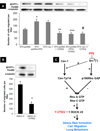Src and caveolin-1 reciprocally regulate metastasis via a common downstream signaling pathway in bladder cancer
- PMID: 21148751
- PMCID: PMC4306590
- DOI: 10.1158/0008-5472.CAN-10-0730
Src and caveolin-1 reciprocally regulate metastasis via a common downstream signaling pathway in bladder cancer
Abstract
In bladder cancer, increased caveolin-1 (Cav-1) expression and decreased Src expression and kinase activity correlate with tumor aggressiveness. Here, we investigate the clinical and functional significance, if any, of this reciprocal expression in bladder cancer metastasis. We evaluated the ability of tumor Cav-1 and Src RNA and protein expression to predict outcome following cystectomy in 257 patients enrolled in two independent clinical studies. In both, high Cav-1 and low Src levels were associated with metastasis development. We overexpressed or depleted Cav-1 and Src protein levels in UMUC-3 and RT4 human bladder cancer cells and evaluated the effect of this on actin stress fibers, migration using Transwells, and lung metastasis following tail vein inoculation. Cav-1 depletion or expression of active Src in metastatic UMUC-3 cells decreases actin stress fibers, cell migration, and metastasis, while Cav-1 overexpression or Src depletion increased the migration of nonmetastatic RT4 cells. Biochemical studies indicated that Cav-1 mediates these effects via its phosphorylated form (pY14), whereas Src effects are mediated through phosphorylation of p190RhoGAP and these pathways converge to reduce activity of RhoA, RhoC, and Rho effector ROCK1. Treatment with a ROCK inhibitor reduced UMUC-3 lung metastasis in vivo, phenocopying the effect of Cav-1 depletion or expression of active Src. Src suppresses whereas Cav-1 promotes metastasis of bladder cancer through a pharmacologically tractable common downstream signaling pathway. Clinical evaluation of personalized therapy to suppress metastasis development based on Cav-1 and Src profiles seems warranted.
Figures






References
-
- Anderson RG, Jacobson K. A role for lipid shells in targeting proteins to caveolae, rafts, and other lipid domains. Science. 2002;296:1821–1825. - PubMed
-
- Ikonen E, Parton RG. Caveolins and cellular cholesterol balance. Traffic. 2000;1:212–217. - PubMed
-
- Del Pozo MA, Schwartz MA. Rac, membrane heterogeneity, caveolin and regulation of growth by integrins. Trends Cell Biol. 2007;17:246–250. - PubMed
-
- Liu P, Rudick M, Anderson RG. Multiple functions of caveolin-1. J Biol Chem. 2002;277:41295–41298. - PubMed
-
- Navarro A, Anand-Apte B, Parat MO. A role for caveolae in cell migration. FASEB J. 2004;18:1801–1811. - PubMed
Publication types
MeSH terms
Substances
Grants and funding
LinkOut - more resources
Full Text Sources
Other Literature Sources
Medical
Miscellaneous

